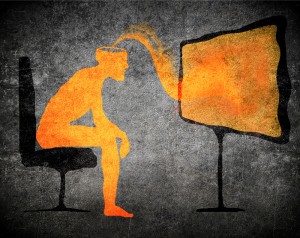E-cigarettes: No smoke without fire?
Posted on 18th December 2014 by Benedict Tate

They come in all manner of colours, flavours, shapes and sizes. Their industry is predicted to be worth £130 million, and their popularity is increasing.[1] They’ve spawned the Oxford English Dictionary’s “word of the year” and now you can even see them on television. But are e-cigarettes the salvation of the 12 million smokers in the UK, or is “vaping” another habit our society needs to kick?
So how do they work?
The principle is relatively simple: in traditional cigarettes tobacco leaves are burnt, releasing smoke to be inhaled into the lungs and thereby delivering a payload of around 5,000 chemicals to the system, including nicotine (making them addictive), various carcinogens (substances which cause cancer), tar (making fingers and teeth yellow), and carbon monoxide (stopping red blood cells and organs getting the oxygen they need).[2] When exhaling, those around the smoker then get a dose of the above through second-hand smoke.
E-cigarettes have some important differences. The concept behind them is that instead of tobacco a cartridge of solution is vaporised and inhaled, thereby exposing the user to addictive nicotine and, in theory, limiting their intake of other harmful substances. This has led to the Medicines and Healthcare Regulatory Agency (MHRA)[3] indicating e-cigarettes could be less harmful than tobacco. The device is battery powered, and can be fitted with flavoured cartridges (chocolate anyone?) which contain different concentrations of nicotine.[4] Some have even had an LED light added to more fully simulate the smoking experience. Ultimately the idea is that they can be used as an aid for those who want to quit, or act as a less harmful alternative for smokers.
What does the evidence say?
 So are e-cigarettes all they’re cracked up to be? A recently published Cochrane review concluded that there is evidence that users of nicotine e-cigarettes are more likely to stop or reduce their smoking in the long term compared those who used e-cigarettes with no nicotine (the placebo).[5] However, the authors do point out that more studies are needed to confirm the effectiveness of e-cigarettes and to further compare the devices with more traditional methods of quitting smoking. This compliments a report published earlier this year by the World Health Organisation (WHO) into electronic nicotine delivery symptoms (or ENDS) which noted the potential effectiveness of vaping in attempts to reduce or stop smoking, but concluded more research was needed.[6]
So are e-cigarettes all they’re cracked up to be? A recently published Cochrane review concluded that there is evidence that users of nicotine e-cigarettes are more likely to stop or reduce their smoking in the long term compared those who used e-cigarettes with no nicotine (the placebo).[5] However, the authors do point out that more studies are needed to confirm the effectiveness of e-cigarettes and to further compare the devices with more traditional methods of quitting smoking. This compliments a report published earlier this year by the World Health Organisation (WHO) into electronic nicotine delivery symptoms (or ENDS) which noted the potential effectiveness of vaping in attempts to reduce or stop smoking, but concluded more research was needed.[6]
As to the health effects of vaping, a small study conducted for the BBC’s “Trust Me, I’m a Doctor” focused on the biological effects of electronic cigarettes by comparing samples from smokers and vapers, finding that while the nicotine levels delivered were similar in both groups, amounts of carbon monoxide and a given carcinogen were “significantly lower” in the vapers. The researchers also found no evidence that passive vaping affected people nearby, and noted that their findings were in line with similar, larger studies.[7]
However, when the US’s Food and Drug Administration carried out a small scale investigation into two leading brands they found some concerning results. While they found that the variability between products meant they could not give a definite answer as to the contents of e-cigarettes generally, the samples they did analyse contained detectable amounts of carcinogens and toxic chemicals. They also found that the quality control used in the manufacture of the products was “inconsistent or non-existent”, and most intriguingly of all that nicotine cartridges labelled as containing “no nicotine” did in fact contain low-level amounts of the addictive substance.[8]
Ultimately the WHO and British Medical Association (BMA) are still concerned about the lack of evidence, with both organisations not only calling for greater regulation of the devices but encouraging a ban of their usage in public and work places until we know more about their long-term effects.
But the questions don’t stop there…
 The recent high profile of e-cigarettes has also led to fears of the societal effects of vaping: for the first time e-cigarettes are now allowed to be advertised on television, while increasing celebrity endorsement makes them an undeniable part of our culture.[9]This has led to fears that e-cigarettes will act as a “gateway” for non-smokers to become addicted to nicotine, spring-boarding them to smoke traditional cigarettes— something particularly concerning when considering that under 18s could be experimenting with the devices.
The recent high profile of e-cigarettes has also led to fears of the societal effects of vaping: for the first time e-cigarettes are now allowed to be advertised on television, while increasing celebrity endorsement makes them an undeniable part of our culture.[9]This has led to fears that e-cigarettes will act as a “gateway” for non-smokers to become addicted to nicotine, spring-boarding them to smoke traditional cigarettes— something particularly concerning when considering that under 18s could be experimenting with the devices.
Evidence to substantiate these concerns is currently divided. The Office for National Statistics recently published a report concluding that “E-cigarettes are almost exclusively used by smokers and ex-smokers. Almost none of those who had never smoked were e-cigarette users”[10], while Public Health England’s survey reports small but statistically significant increases in numbers of children using e-cigarettes internationally in the past few years.[11] Interestingly, a survey for the Welsh government actually found that 6% of children surveyed had tried e-cigarettes— three times as many as had tried conventional smoking.[12]
Other questions include whether, even if the safety of e-cigarettes were to be established, we should be facilitating the growing and widespread use of an addictive substance like nicotine.[13] Further concerns regard the potential effects of nicotine beyond addictiveness; it is thought it may contribute to cardiovascular disease, its effect on biological processes has led to its classification as “a possible tumour promoter”, while ingestion of the chemical can have adverse effects during pregnancy. It is also linked to malignant diseases and neurodegeneration (both as nasty as they sound).[14]
More evidence will help us get a more accurate picture of the impact of vaping on society and on our bodies.
Conclusions
The recent popularity in e-cigarettes means we can expect that more answers to our questions will be forthcoming as time goes on, with the conclusion of on-going clinical trials and the planned governmental regulation of e-cigarettes from 2016.
Current NHS advice is cautious, reiterating that while e-cigarettes may be safer than conventional cigarettes, the need for clinical trials means tried-and-tested methods to quit smoking still have more predictable long-term effects.[15] However, the increasing popularity of the devices coupled with their potential benefits to smokers makes this technology a fascinating development in the fight against smoking.
Links
[1]https://www.gov.uk/government/uploads/system/uploads/attachment_data/file/311491/Ecigarette_uptake_and_marketing.pdf
[2] http://www.cancerresearchuk.org/cancer-info/healthyliving/smoking-and-cancer/whats-in-a-cigarette/smoking-and-cancer-whats-in-a-cigarette
[3] https://www.nice.org.uk/guidance/ph45
[4] http://science.howstuffworks.com/innovation/everyday-innovations/electronic-cigarette1.htm
[5] http://onlinelibrary.wiley.com/doi/10.1002/14651858.CD010216.pub2/abstract
[6] http://www.who.int/nmh/events/2014/backgrounder-e-cigarettes/en/
[7] http://www.bbc.co.uk/programmes/articles/h48GpcKL8BqrNsx8WjQTJf/are-e-cigarettes-safe
[8] http://www.fda.gov/NewsEvents/PublicHealthFocus/ucm173146.htm
[9] http://www.pinterest.com/ecigreviewed/e-cigarettes-celebrities/
[10] http://www.ons.gov.uk/ons/dcp171778_386291.pdf Emphasis added.
[11] https://www.gov.uk/government/uploads/system/uploads/attachment_data/file/311491/Ecigarette_uptake_and_marketing.pdf
[12] http://wales.gov.uk/docs/caecd/research/2014/140715-exposure-secondhand-smoke-cars-ecigarette-use-among-10-11-year-olds-chets-2-en.pdf
[13] http://www.bbc.co.uk/programmes/articles/h48GpcKL8BqrNsx8WjQTJf/are-e-cigarettes-safe
[14] http://apps.who.int/gb/fctc/PDF/cop6/FCTC_COP6_10-en.pdf?ua=1
[15] http://www.nhs.uk/conditions/smoking-%28quitting%29/Pages/Treatment.aspx




No Comments on E-cigarettes: No smoke without fire?